Multitemporal Incidence of Landscape Fragmentation in a Protected Area of Central Andean Ecuador
Abstract
1. Introduction
2. Materials and Methods
2.1. Study Area
2.2. Satellite Image Processing
2.3. Supervised Classification
2.4. Post Classification
2.5. Landscape Metrics and Indices
3. Results
3.1. Land Cover Classification
3.1.1. Confusion Matrix and Overall Accuracy
3.1.2. Landscape Metrics and Indices
3.1.3. Statistical Analysis
4. Discussion
5. Conclusions
Author Contributions
Funding
Data Availability Statement
Conflicts of Interest
References
- Abdullah, H.M.; Islam, I.; Miah, G.; Ahmed, Z. Quantifying the spatiotemporal patterns of forest degradation in a fragmented, rapidly urbanizing landscape: A case study of Gazipur, Bangladesh. Remote Sens. Appl. Soc. Environ. 2019, 13, 457–465. [Google Scholar] [CrossRef]
- Steffen, W.; Crutzen, P.J.; McNeill, J.R. The Anthropocene: Are humans now overwhelming the great forces of Nature. AMBIO J. Hum. Environ. 2007, 36, 614–621. [Google Scholar] [CrossRef]
- Allam, M.; Bakr, N.; Elbably, W. Multi-temporal assessment of land use/land cover change in arid region based on landsat satellite imagery: Case study in Fayoum Region, Egypt. Remote Sens. Appl. Soc. Environ. 2019, 14, 8–19. [Google Scholar] [CrossRef]
- Gao, J.; Li, F.; Gao, H.; Zhou, C.; Zhang, X. The impact of land-use change on water-related ecosystem services: A study of the Guishui River Basin, Beijing, China. J. Clean. Prod. 2017, 163, S148–S155. [Google Scholar] [CrossRef]
- Vitousek, P.M.; Aber, J.D.; Howarth, R.W.; Likens, G.E.; Matson, P.A.; Schindler, D.W.; Schlesinger, W.H.; Tilman, D.G. Human alteration of the global nitrogen cycle: Sources and consequences. Ecol. Appl. 1997, 7, 737–750. [Google Scholar] [CrossRef]
- Birhanu, L.; Hailu, B.T.; Bekele, T.; Demissew, S. Land use/land cover change along elevation and slope gradient in highlands of Ethiopia. Remote Sens. Appl. Soc. Environ. 2019, 16, 100260. [Google Scholar] [CrossRef]
- Nkeki, F.N. Spatio-temporal analysis of land use transition and urban growth characterization in Benin metropolitan region, Nigeria. Remote Sens. Appl. Soc. Environ. 2016, 4, 119–137. [Google Scholar] [CrossRef]
- Love, B.J.; Nejadhashemi, A.P. Water quality impact assessment of large-scale biofuel crops expansion in agricultural regions of Michigan. Biomass Bioenergy 2011, 35, 2200–2216. [Google Scholar] [CrossRef]
- Turner, R.E.; Rabalais, N.N. Linking landscape and water quality in the Mississippi River Basin for 200 years. BioScience 2003, 53, 563–572. [Google Scholar] [CrossRef]
- Japelaghi, M.; Gholamalifard, M.; Shayesteh, K. Spatio-temporal analysis and prediction of landscape patterns and change processes in the Central Zagros region, Iran. Remote Sens. Appl. Soc. Environ. 2019, 15, 100244. [Google Scholar] [CrossRef]
- Gomez-Casanovas, N.; Matamala, R.; Cook, D.R.; Gonzalez-Meler, M.A. Net ecosystem exchange modifies the relationship between the autotrophic and heterotrophic components of soil respiration with abiotic factors in prairie grasslands. Glob. Chang. Biol. 2012, 18, 2532–2545. [Google Scholar] [CrossRef]
- Mendoza, S.J.E.; Etter, R.A. Multitemporal analysis (1940–1996) of land cover changes in the southwestern Bogotá highplain (Colombia). Landsc. Urban Plan. 2002, 59, 147–158. [Google Scholar] [CrossRef]
- Zhou, T.; Zhang, J.; Qin, Y.; Jiang, M.; Qiao, X. The Effects of Biotic and Abiotic Factors on the Community Dynamics in a Mountain Subtropical Forest. Forests 2021, 12, 427. [Google Scholar] [CrossRef]
- Cayambe, J.; Torres, B.; Cabrera, F.; Díaz-Ambrona, C.G.H.; Toulkeridis, T.; Heredia-R, M. Changes of Land Use and Land Cover in Hotspots within the Western Amazon: The Case of the Yasuní Biosphere Reserve; Springer: Berlin/Heidelberg, Germany, 2023; pp. 213–223. [Google Scholar] [CrossRef]
- Heredia-R, M.; Cayambe, J.; Schorsch, C.; Toulkeridis, T.; Barreto, D.; Poma, P.; Villegas, G. Multitemporal Analysis as a Non-Invasive Technology Indicates a Rapid Change in Land Use in the Amazon: The Case of the ITT Oil Block. Environments 2021, 8, 139. [Google Scholar] [CrossRef]
- Parmesan, C. Ecological and Evolutionary Responses to Recent Climate Change. Annu. Rev. Ecol. Evol. Syst. 2006, 37, 637–669. [Google Scholar] [CrossRef]
- Toulkeridis, T.; Zach, I. Wind directions of volcanic ash-charged clouds in Ecuador—Implications for the public and flight safety. Geomat. Nat. Hazards Risk 2016, 8, 242–256. [Google Scholar] [CrossRef]
- Du, P.; Li, X.; Cao, W.; Luo, Y.; Zhang, H. Monitoring urban land cover and vegetation change by multi-temporal remote sensing information. Min. Sci. Technol. 2010, 20, 922–932. [Google Scholar] [CrossRef]
- Hua, L.; Shao, G.; Zhao, J. A concise review of ecological risk assessment for urban ecosystem application associated with rapid urbanization processes. Int. J. Sustain. Dev. World Ecol. 2016, 24, 248–261. [Google Scholar] [CrossRef]
- Roy, A. Land Use and Land Cover Change in India: A Remote Sensing & GIS Prespective. 2010. Available online: https://www.researchgate.net/publication/289770159 (accessed on 3 January 2023).
- Kankam, S.; Osman, A.; Inkoom, J.N.; Fürst, C. Implications of Spatio-Temporal Land Use/Cover Changes for Ecosystem Services Supply in the Coastal Landscapes of Southwestern Ghana, West Africa. Land 2022, 11, 1408. [Google Scholar] [CrossRef]
- Shimrah, T.; Sarma, K.; Varga, O.G.; Szilard, S.; Singh, S.K. Quantitative assessment of landscape transformation using earth observation datasets in Shirui Hill of Manipur, India. Remote Sens. Appl. Soc. Environ. 2019, 15, 100237. [Google Scholar] [CrossRef]
- de León Mata, G.D.; Pinedo Álvarez, A.; Martínez Guerrero, J.H. Application of remote sensing in the analysis of landscape fragmentation in Cuchillas de la Zarca, Mexico. Investig. Geogr. 2014, 84. [Google Scholar] [CrossRef]
- Murad, C.A.; Pearse, J. Landsat study of deforestation in the Amazon region of Colombia: Departments of Caquetá and Putumayo. Remote Sens. Appl. Soc. Environ. 2018, 11, 161–171. [Google Scholar] [CrossRef]
- Mugiraneza, T.; Ban, Y.; Haas, J. Urban land cover dynamics and their impact on ecosystem services in Kigali, Rwanda using multi-temporal Landsat data. Remote Sens. Appl. Soc. Environ. 2018, 13, 234–246. [Google Scholar] [CrossRef]
- Reddy, C.S.; Saranya, K.; Jha, C.; Dadhwal, V.; Murthy, Y.K. Earth observation data for habitat monitoring in protected areas of India. Remote Sens. Appl. Soc. Environ. 2017, 8, 114–125. [Google Scholar] [CrossRef]
- Belenok, V.; Noszczyk, T.; Hebryn-Baidy, L.; Kryachok, S. Investigating anthropogenically transformed landscapes with remote sensing. Remote Sens. Appl. Soc. Environ. 2021, 24, 100635. [Google Scholar] [CrossRef]
- Foley, J.A.; Asner, G.; Costa, M.; Coe, M.T.; DeFries, R.; Gibbs, H.K.; Howard, E.A.; Olson, S.; Patz, J.; Ramankutty, N.; et al. Amazonia revealed: Forest degradation and loss of ecosystem goods and services in the Amazon Basin. Front. Ecol. Environ. 2007, 5, 25–32. [Google Scholar] [CrossRef]
- Herzog, S.K.; Martínez, R.; Jørgensen, P.M.; Tiessen, H. (Eds.) Climate Change and Biodiversity in the Tropical Andes; IAI: Montevideo, Uruguay, 2017. [Google Scholar]
- Rimal, B.; Sharma, R.; Kunwar, R.; Keshtkar, H.; Stork, N.E.; Rijal, S.; Rahman, S.A.; Baral, H. Effects of land use and land cover change on ecosystem services in the Koshi River Basin, Eastern Nepal. Ecosyst. Serv. 2019, 38, 100963. [Google Scholar] [CrossRef]
- Mondal, A.; Kundu, S.; Chandniha, D.K.; Shukla, R.; Chandniha, S.; Mishra, P.K. Comparison of support vector machine and maximum likelihood classification technique using satellite imagery. Int. J. Remote Sens. GIS 2012, 1, 116–123. [Google Scholar]
- Zelený, J.; Mercado-Bettín, D.; Müller, F. Towards the evaluation of regional ecosystem integrity using NDVI, brightness temperature and surface heterogeneity. Sci. Total Environ. 2021, 796, 148994. [Google Scholar] [CrossRef]
- Valentini, E.; Taramelli, A.; Filipponi, F.; Giulio, S. An effective procedure for EUNIS and Natura 2000 habitat type mapping in estuarine ecosystems integrating ecological knowledge and remote sensing analysis. Ocean Coast. Manag. 2015, 108, 52–64. [Google Scholar] [CrossRef]
- Madhu, K.; Pauliuk, S.; Dhathri, S.; Creutzig, F. Understanding environmental trade-offs and resource demand of direct air capture technologies through comparative life-cycle assessment. Nat. Energy 2021, 6, 1035–1044. [Google Scholar] [CrossRef]
- ECOLAP and MAE. Ubicación Geográfica de la Región Sierra Escala 1: 2’700.000 aprox. Available online: https://www.parks-and-tribes.com/national-parks/parque-nacional-llanganates/parque-nacional-llanganates.pdf (accessed on 3 January 2023).
- Ron, S.R.; Navarrete, M.J.; Venegas, P. Two new species of frogs of the genus Pristimantis from Llanganates National Park in Ecuador with comments on the regional diversity of Ecuadorian Pristimantis (Anura, Craugastoridae). Zookeys 2016, 593, 139–162. [Google Scholar] [CrossRef]
- Ortega, J.A.; Brito, J.; Ron, S.R. Six new species of Pristimantis (Anura: Strabomantidae) from Llanganates National Park and Sangay National Park in Amazonian cloud forests of Ecuador. PeerJ 2022, 10, e13761. [Google Scholar] [CrossRef]
- Orozco, C.I.; Pérez, Á.J.; Romoleroux, K.; Aldana, J.M. The discovery of a new species of Brunellia (Brunelliaceae) with ephemeral petals from Llanganates National Park, Ecuador. Phytotaxa 2017, 311, 263–269. [Google Scholar] [CrossRef]
- Guevara, M.-F.; Salazar, P.; Mátyás, B.; Ordoñez, M.-E. Xylariales: First results of mycological exploration in the Sangay and Llanganates National Park, Ecuador. F1000Research 2018, 7, 222. [Google Scholar] [CrossRef]
- Palacios, J.; Naveda-Rodríguez, A.; Zapata-Ríos, G. Large mammal richness in Llanganates National Park, Ecuador. Mammalia 2017, 82, 309–314. [Google Scholar] [CrossRef]
- Villota, A.; León-Yánez, S.; Behling, H. Mid- and late Holocene vegetation and environmental dynamics in the Llanganates National Park, Anteojos Valley, central Ecuadorian Andes. Palynology 2014, 39, 350–361. [Google Scholar] [CrossRef]
- Gong, J.; Sui, H.; Ma, G.; Zhou, Q. A Review of Multi-Temporal Remote Sensing Data Change Detection Algorithms. 2008. Available online: https://www.researchgate.net/publication/241682221 (accessed on 3 January 2023).
- Cooley, T.; Anderson, G.P.; Felde, G.W.; Hoke, M.L.; Ratkowski, A.J.; Chetwynd, J.H.; Gardner, J.A.; Adler-Golden, S.M.; Matthew, M.W.; Berk, A.; et al. FLAASH, a MODTRAN4-based Atmospheric Correction Algorithm, Its Application and Validation. In Proceedings of the IEEE International Geoscience and Remote Sensing Symposium, Toronto, ON, Canada, 24–28 June 2002. [Google Scholar]
- Uzoukwu, C.U. Using GIS to Detect Changes in Land Use Land Cover for Electrical Transmission Line Siting and Expansion Planning in Winona County. 2010. Available online: http://www.gis.smumn.edu (accessed on 3 January 2023).
- Gomez-Chova, L.; Tuia, D.; Moser, G.; Camps-Valls, G. Multimodal Classification of Remote Sensing Images: A Review and Future Directions. Proc. IEEE 2015, 103, 1560–1584. [Google Scholar] [CrossRef]
- Foody, G.M.; Mathur, A. Toward intelligent training of supervised image classifications: Directing training data acquisition for SVM classification. Remote Sens. Environ. 2004, 93, 107–117. [Google Scholar] [CrossRef]
- Polat, N.; Kaya, Y. Intercontinental Geoinformation Days an Investigation of Supervised LCLU Classification Performance over UAV Based Orthophoto. Available online: http://igd.mersin.edu.tr/2020/ (accessed on 3 January 2023).
- Ehsan, S.; Kazem, D. Analysis of land use-land covers changes using normalized difference vegetation index (NDVI) differencing and classification methods. Afr. J. Agric. Res. 2013, 8, 4614–4622. [Google Scholar] [CrossRef]
- Sathya, P. Analysis of Supervised Image Classification Method for Satellite Images. Int. J. Comput. Sci. Res. (IJCSR) 2017, 5, 16–19. [Google Scholar]
- Zaidi, S.M.; Akbari, A.; Abu Samah, A.; Kong, N.S.; Gisen, J.I.A. Landsat-5 Time Series Analysis for Land Use/Land Cover Change Detection Using NDVI and Semi-Supervised Classification Techniques. Pol. J. Environ. Stud. 2017, 26, 2833–2840. [Google Scholar] [CrossRef]
- Conese, C.; Maselli, F. Use of Error Matrices to Improve Area Estimates with Maximum Likelihood Classification Procedures. Remote Sens. Environ. 1992, 40, 113–124. [Google Scholar] [CrossRef]
- Niu, X.; Hu, Y.; Lei, Z.; Wang, H.; Zhang, Y.; Yan, H. Spatial and Temporal Evolution Characteristics of Land Use/Cover and Its Driving Factor in Cambodia during 2000–2020. Land 2022, 11, 1556. [Google Scholar] [CrossRef]
- Awuah, K.T.; Nölke, N.; Freudenberg, M.; Diwakara, B.; Tewari, V.; Kleinn, C. Spatial resolution and landscape structure along an urban-rural gradient: Do they relate to remote sensing classification accuracy?—A case study in the megacity of Bengaluru, India. Remote Sens. Appl. Soc. Environ. 2018, 12, 89–98. [Google Scholar] [CrossRef]
- Elkie, P.; Rempel, R.; Angus, P. Patch Analyst User’s Manual. 1999. Available online: https://www.yumpu.com/en/document/read/29088001/patch-analyst-users-manual (accessed on 3 January 2023).
- Sapena, M.; Ruiz, L. Guía de Usuario IndiFrag v2.1. 2016. Available online: https://cgat.webs.upv.es/BigFiles/indifrag/GuiaUsuario_IndiFrag_v2.1.pdf (accessed on 3 January 2023).
- Toulkeridis, T.; Tamayo, E.; Simón-Baile, D.; Merizalde-Mora, M.J.; Reyes-Yunga, D.F.R.; Viera-Torres, M.; Heredia, M. Climate Change according to Ecuadorian academics–Perceptions versus facts. Granja 2020, 31, 21–49. [Google Scholar] [CrossRef]
- Vaca, A.; Arroyo, C.R.; Debut, A.; Toulkeridis, T.; Cumbal, L.; Mato, F.; Aguilera, M.C.D.A.E. Characterization of Fine-grained Material Ejected by the Cotopaxi Volcano Employing X-ray Diffraction and Electron Diffraction Scattering Techniques. Biol. Med. 2016, 8. [Google Scholar] [CrossRef]
- Biratu, A.A.; Bedadi, B.; Gebrehiwot, S.G.; Melesse, A.M.; Nebi, T.H.; Abera, W.; Tamene, L.; Egeru, A. Impact of Landscape Management Scenarios on Ecosystem Service Values in Central Ethiopia. Land 2022, 11, 1266. [Google Scholar] [CrossRef]
- Wang, Y.; Rao, Y.; Zhu, H. Revealing the Impact of Protected Areas on Land Cover Volatility in China. Land 2022, 11, 1361. [Google Scholar] [CrossRef]
- Zhao, S.; Fan, Z.; Gao, X. Spatiotemporal Dynamics of Land Cover and Their Driving Forces in the Yellow River Basin since 1990. Land 2022, 11, 1563. [Google Scholar] [CrossRef]
- Lozano, P.; Cabrera, O.; Peyre, G.; Cleef, A.; Toulkeridis, T. Plant Diversity and Composition Changes along an Altitudinal Gradient in the Isolated Volcano Sumaco in the Ecuadorian Amazon. Diversity 2020, 12, 229. [Google Scholar] [CrossRef]
- Arroyo-Rodríguez, V.; Arasa-Gisbert, R.; Arce-Peña, N.P.; Cervantes-López, M. Determinantes de la Biodiversidad en Paisajes Antrópicos: Una Revisión Teórica. Universidad Autónoma del Estado de Hidalgo y Libermex. 2019. Available online: https://www.researchgate.net/publication/338557779_Determinantes_de_la_biodiversidad_en_paisajes_antropicos_Una_revision_teorica (accessed on 3 January 2023).
- Pal, S.; Singha, P.; Lepcha, K.; Debanshi, S.; Talukdar, S.; Saha, T.K. Proposing multicriteria decision based valuation of ecosystem services for fragmented landscape in mountainous environment. Remote Sens. Appl. Soc. Environ. 2020, 21, 100454. [Google Scholar] [CrossRef]
- Popov, M.; Michaelides, S.; Stankevich, S.; Kozlova, A.; Piestova, I.; Lubskiy, M.; Titarenko, O.; Svideniuk, M.; Andreiev, A.; Ivanov, S. Assessing long-term land cover changes in watershed by spatiotemporal fusion of classifications based on probability propagation: The case of Dniester river basin. Remote Sens. Appl. Soc. Environ. 2021, 22, 100477. [Google Scholar] [CrossRef]
- Sugianto, S.; Deli, A.; Miswar, E.; Rusdi, M.; Irham, M. The Effect of Land Use and Land Cover Changes on Flood Occurrence in Teunom Watershed, Aceh Jaya. Land 2022, 11, 1271. [Google Scholar] [CrossRef]
- Xu, C.; Fu, H.; Yang, J.; Wang, L. Assessment of the Relationship between Land Use and Flood Risk Based on a Coupled Hydrological–Hydraulic Model: A Case Study of Zhaojue River Basin in Southwestern China. Land 2022, 11, 1182. [Google Scholar] [CrossRef]
- López-Rodríguez, F.; Rosado, D. Management effectiveness evaluation in protected areas of southern Ecuador. J. Environ. Manag. 2017, 190, 45–52. [Google Scholar] [CrossRef]
- Yi, H.; Güneralp, B.; Filippi, A.M.; Kreuter, U.P.; Güneralp, İ. Impacts of Land Change on Ecosystem Services in the San Antonio River Basin, Texas, from 1984 to 2010. Ecol. Econ. 2017, 135, 125–135. [Google Scholar] [CrossRef]
- Strange, E.M.; Fausch, K.D.; Covich, A.P. Sustaining Ecosystem Services in Human-Dominated Watersheds: Biohydrology and Ecosystem Processes in the South Platte River Basin. Environ. Manag. 1999, 24, 39–54. [Google Scholar] [CrossRef]
- Terrado, M.; Momblanch, A.; Bardina, M.; Boithias, L.; Munné, A.; Sabater, S.; Solera, A.; Acuña, V. Integrating ecosystem services in river basin management plans. J. Appl. Ecol. 2016, 53, 865–875. [Google Scholar] [CrossRef]
- Sobhani, P.; Esmaeilzadeh, H.; Mostafavi, H. Simulation and impact assessment of future land use and land cover changes in two protected areas in Tehran, Iran. Sustain. Cities Soc. 2021, 75, 103296. [Google Scholar] [CrossRef]
- Zefrehei, A.R.P.; Hedayati, S.; Sahraei, H. Long-term dynamic analysis based on Landsat imagery in the Gorgan Bay-Gomishan Wetland, Iran. Casp. J. Environ. Sci. 2022, 20, 721–727. [Google Scholar] [CrossRef]
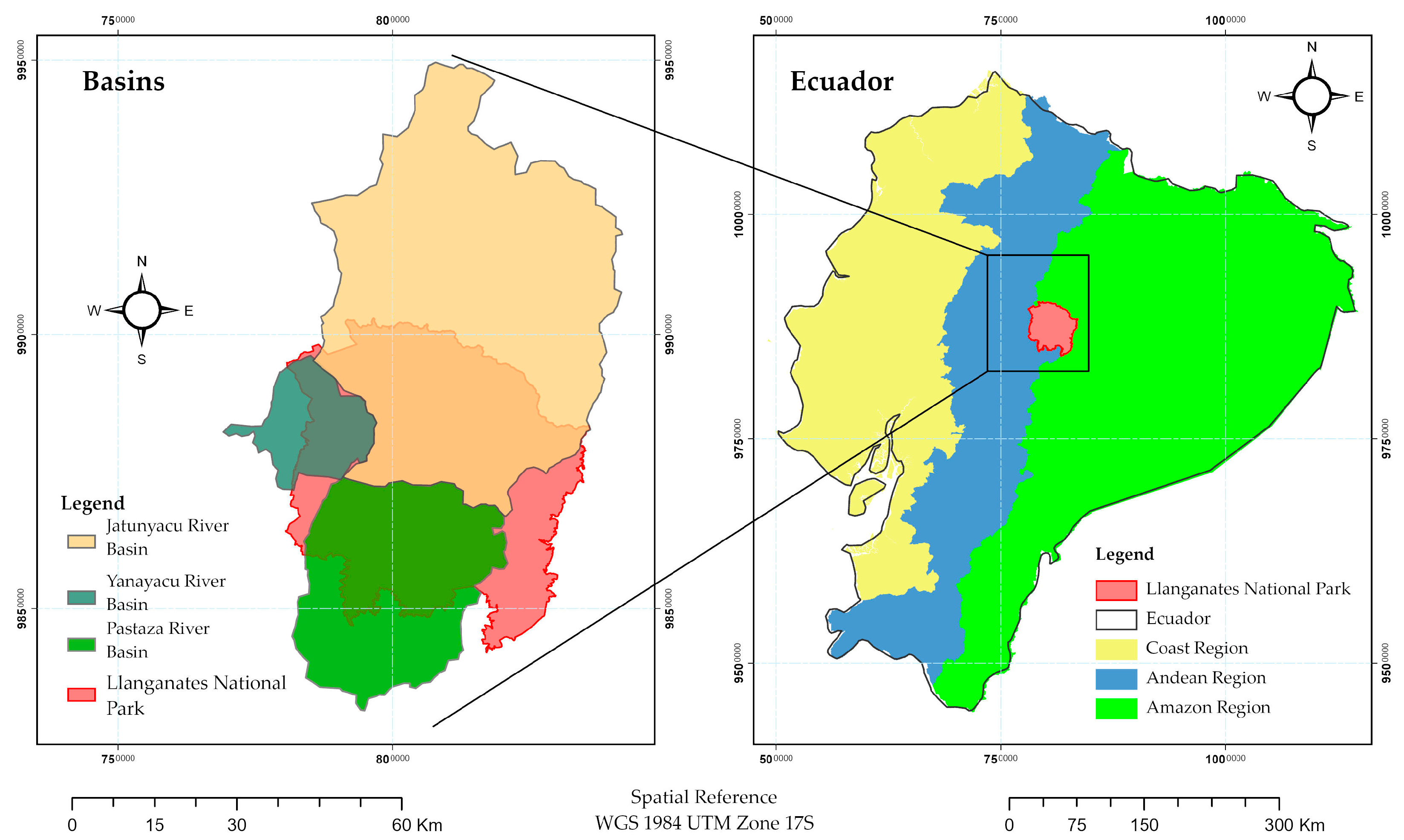
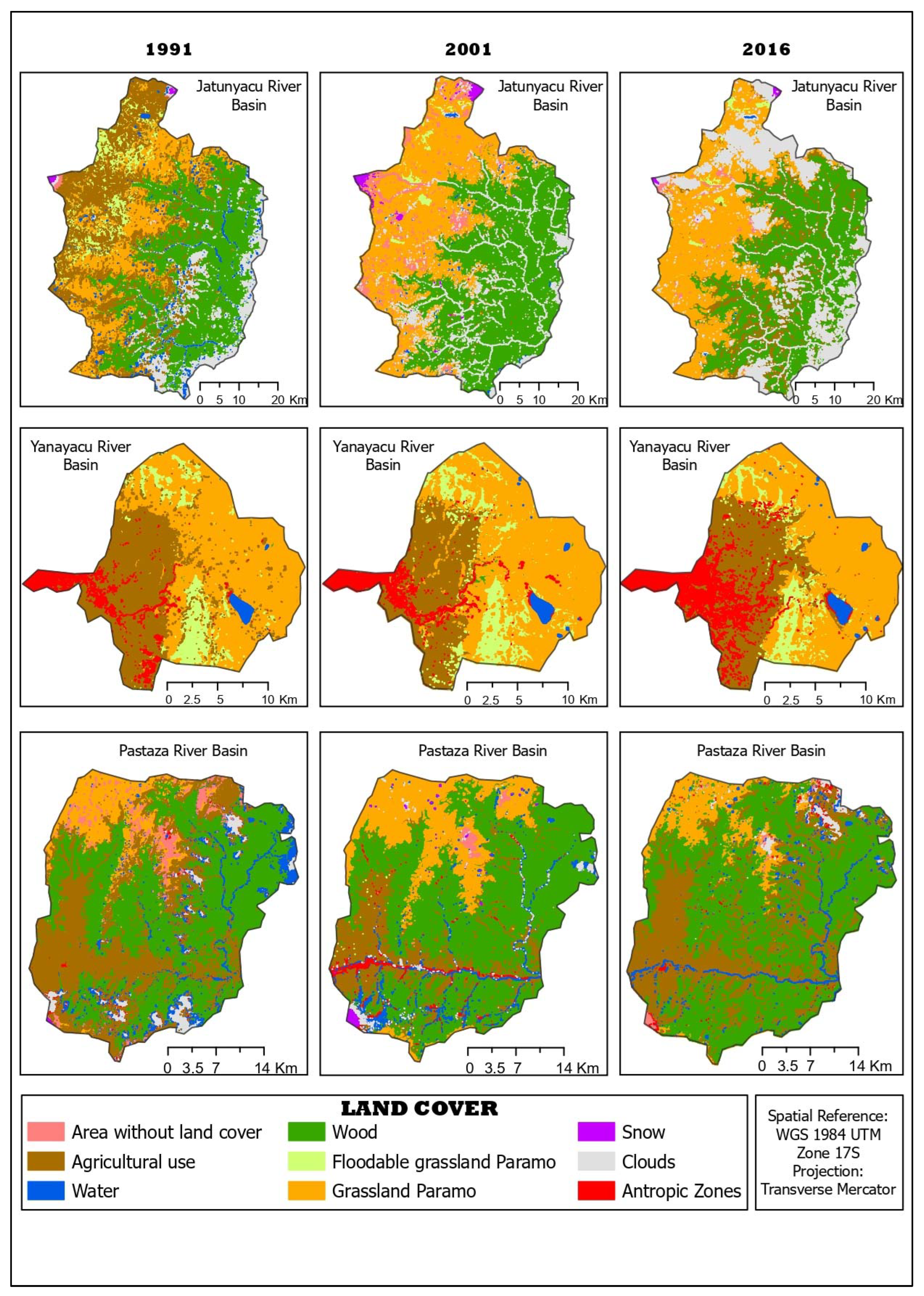
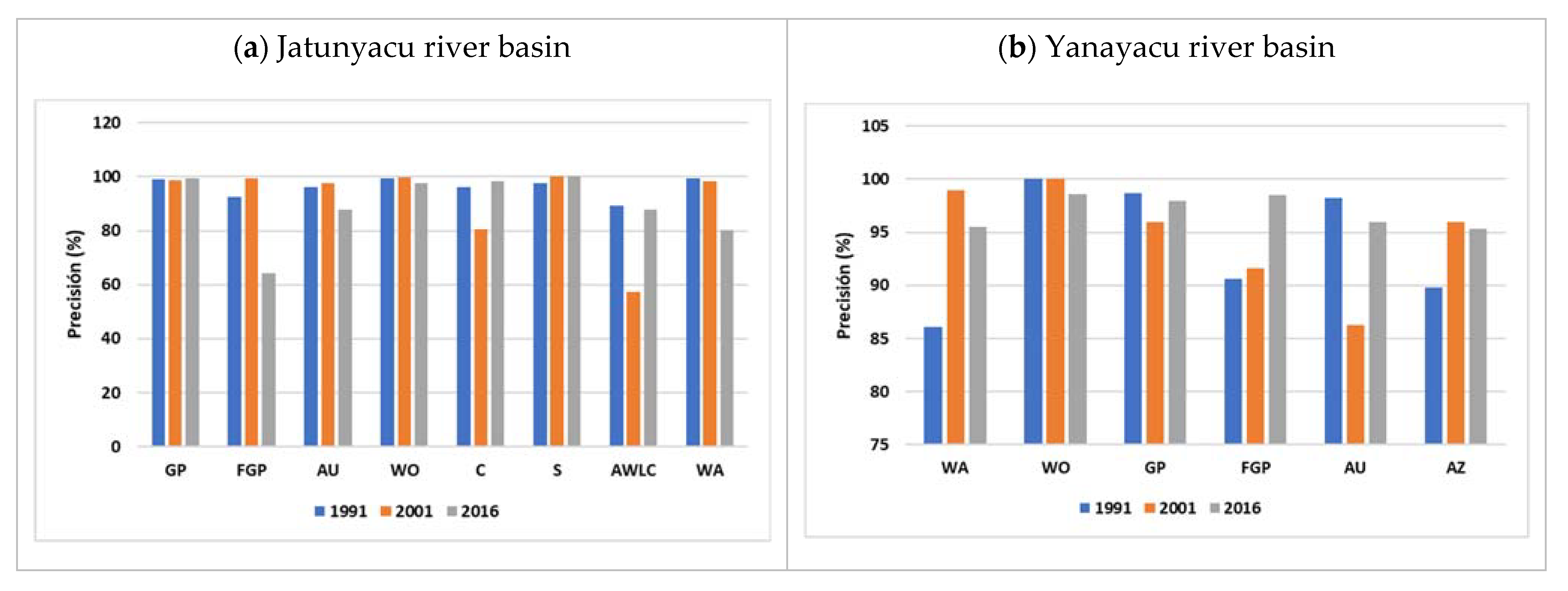
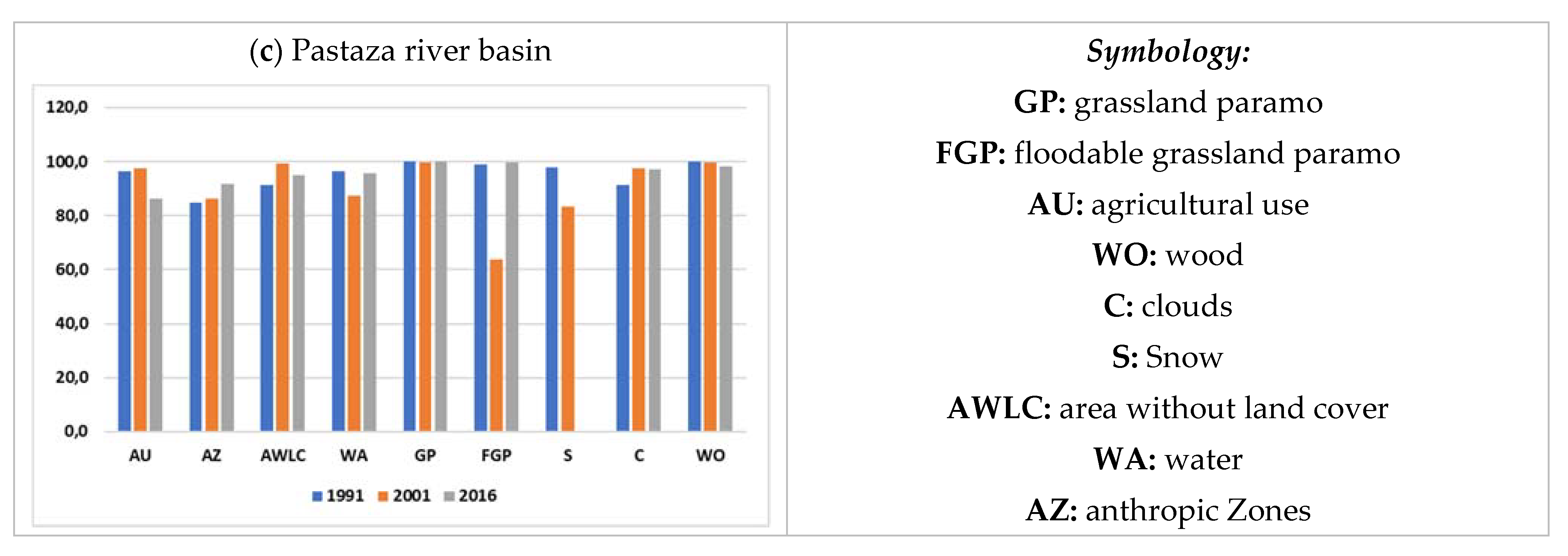
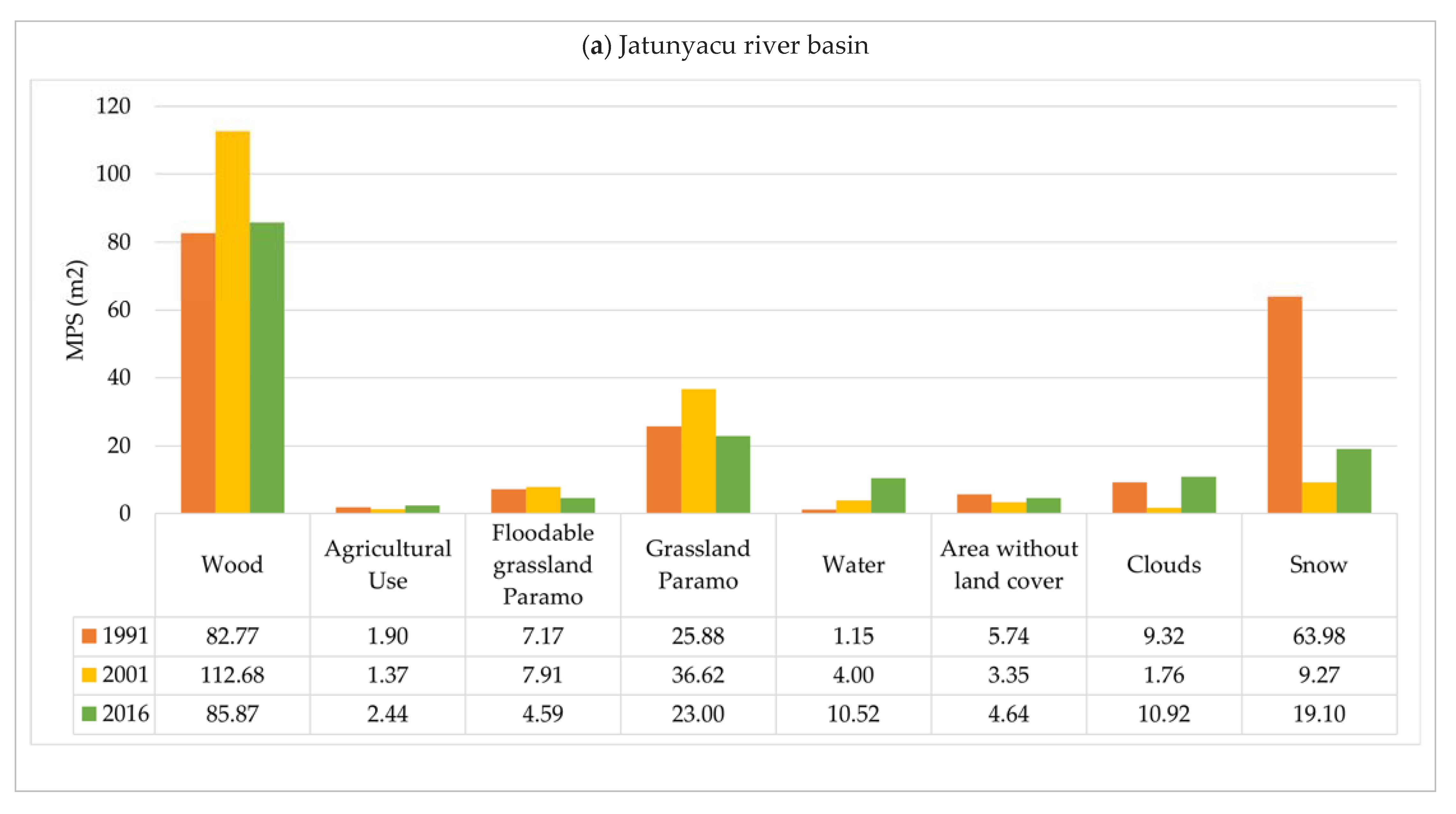
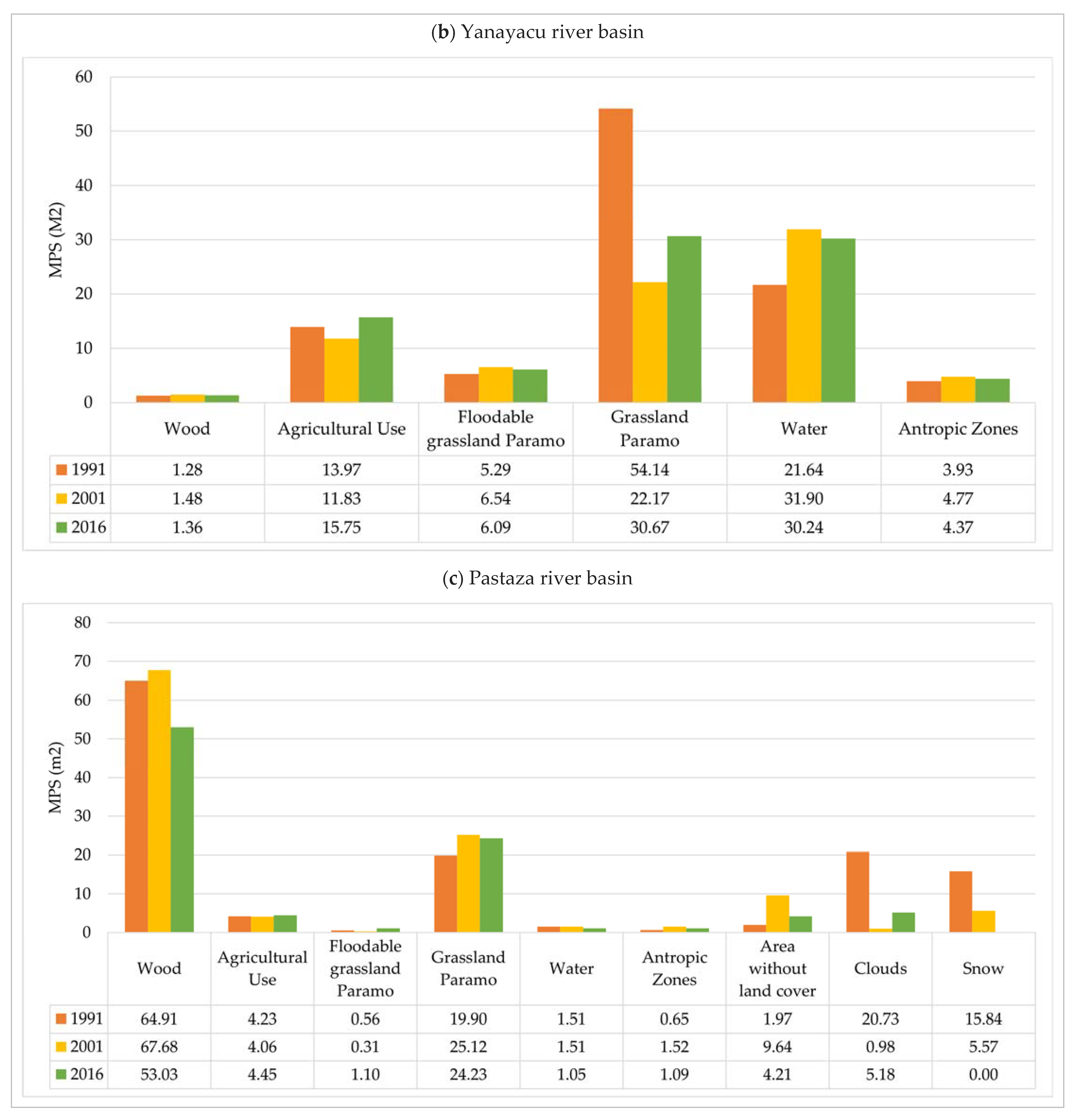
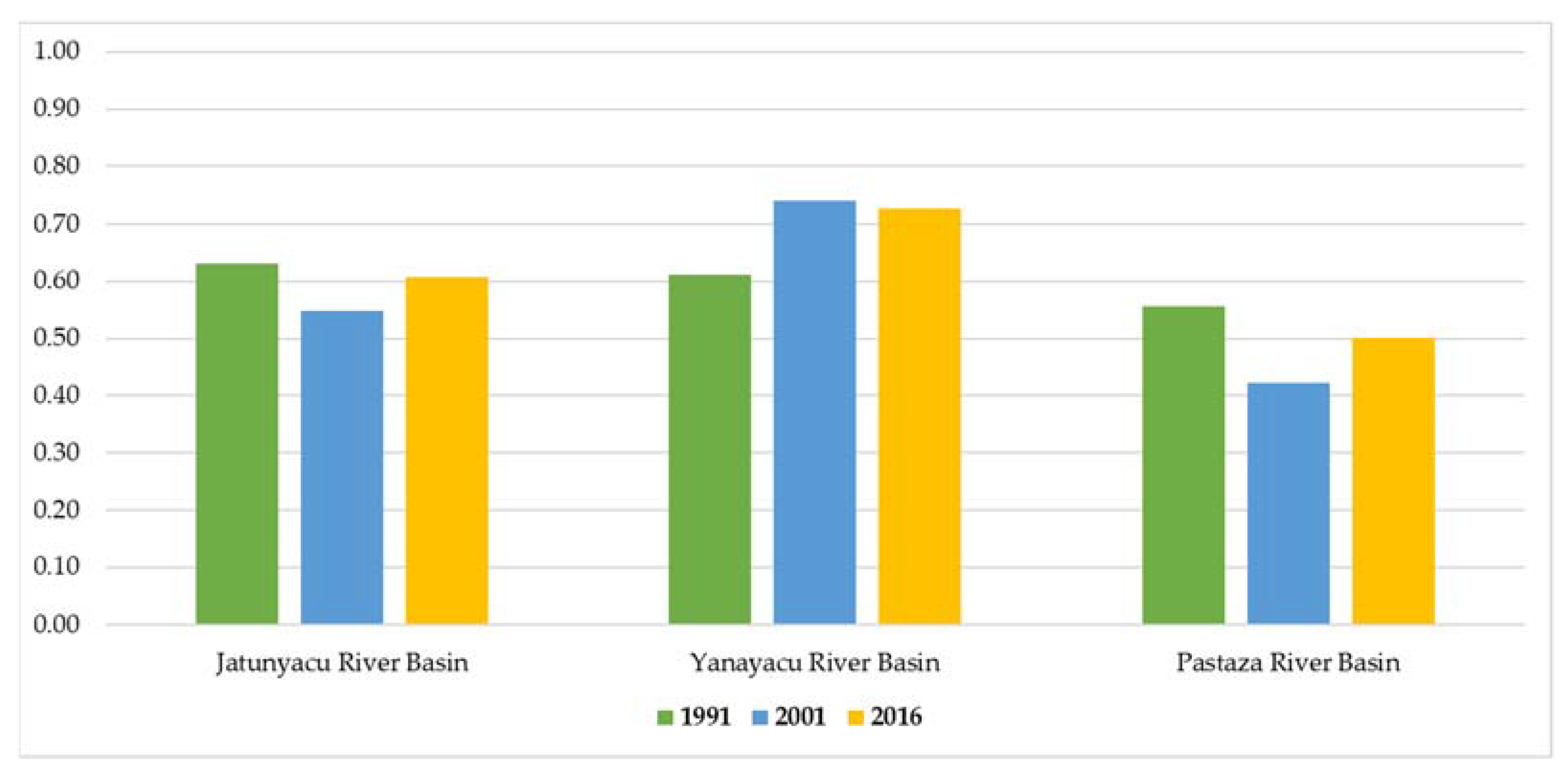
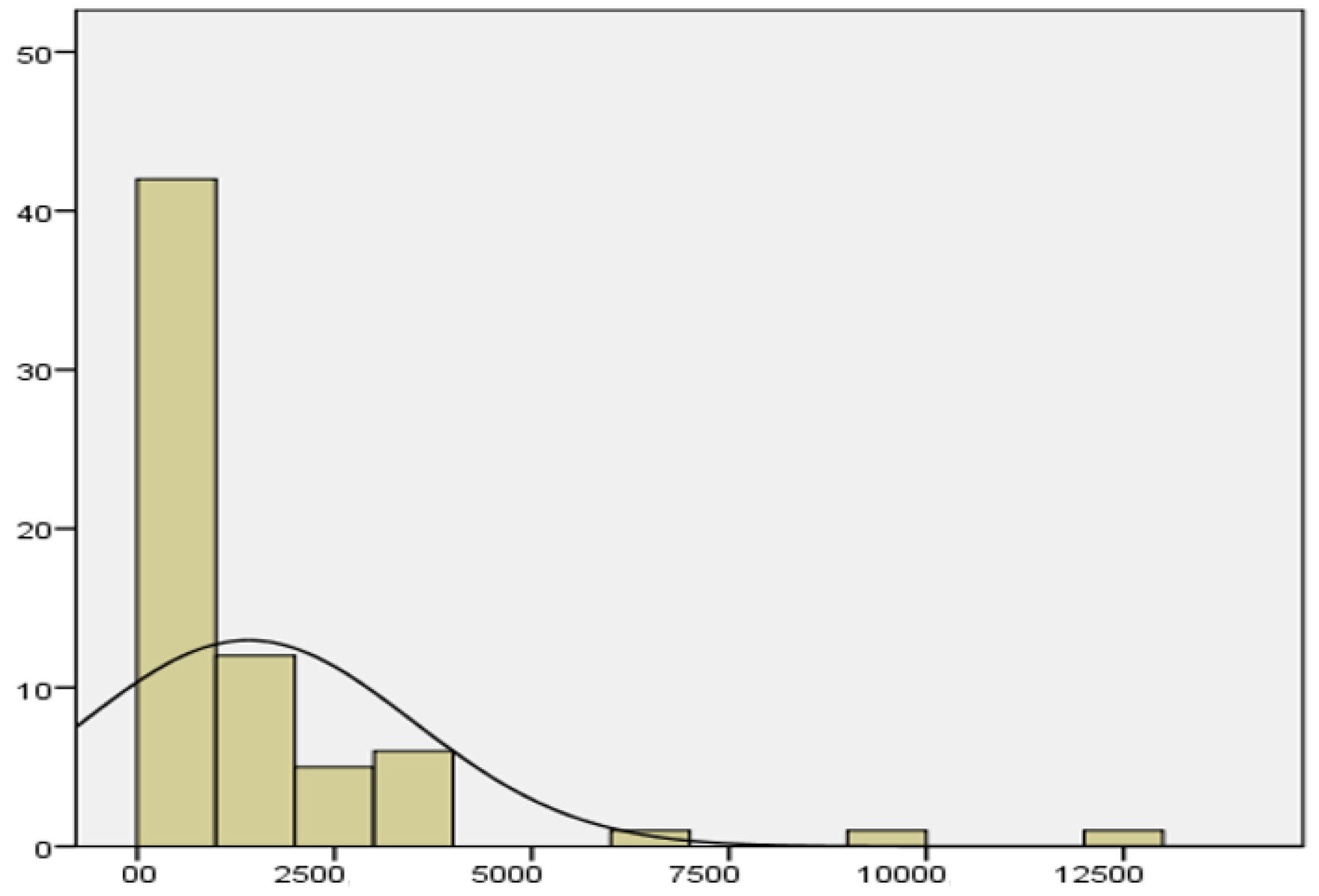
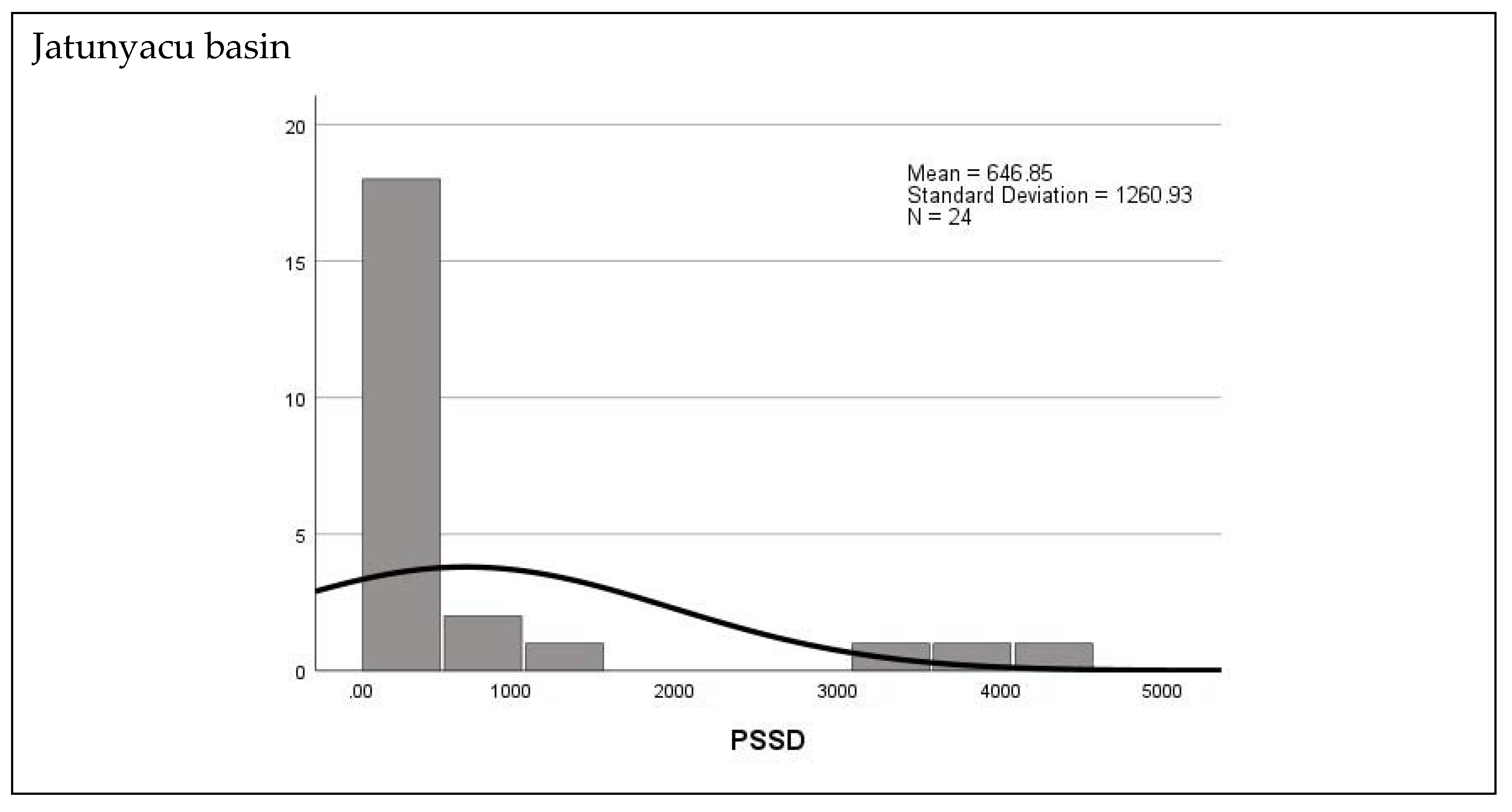
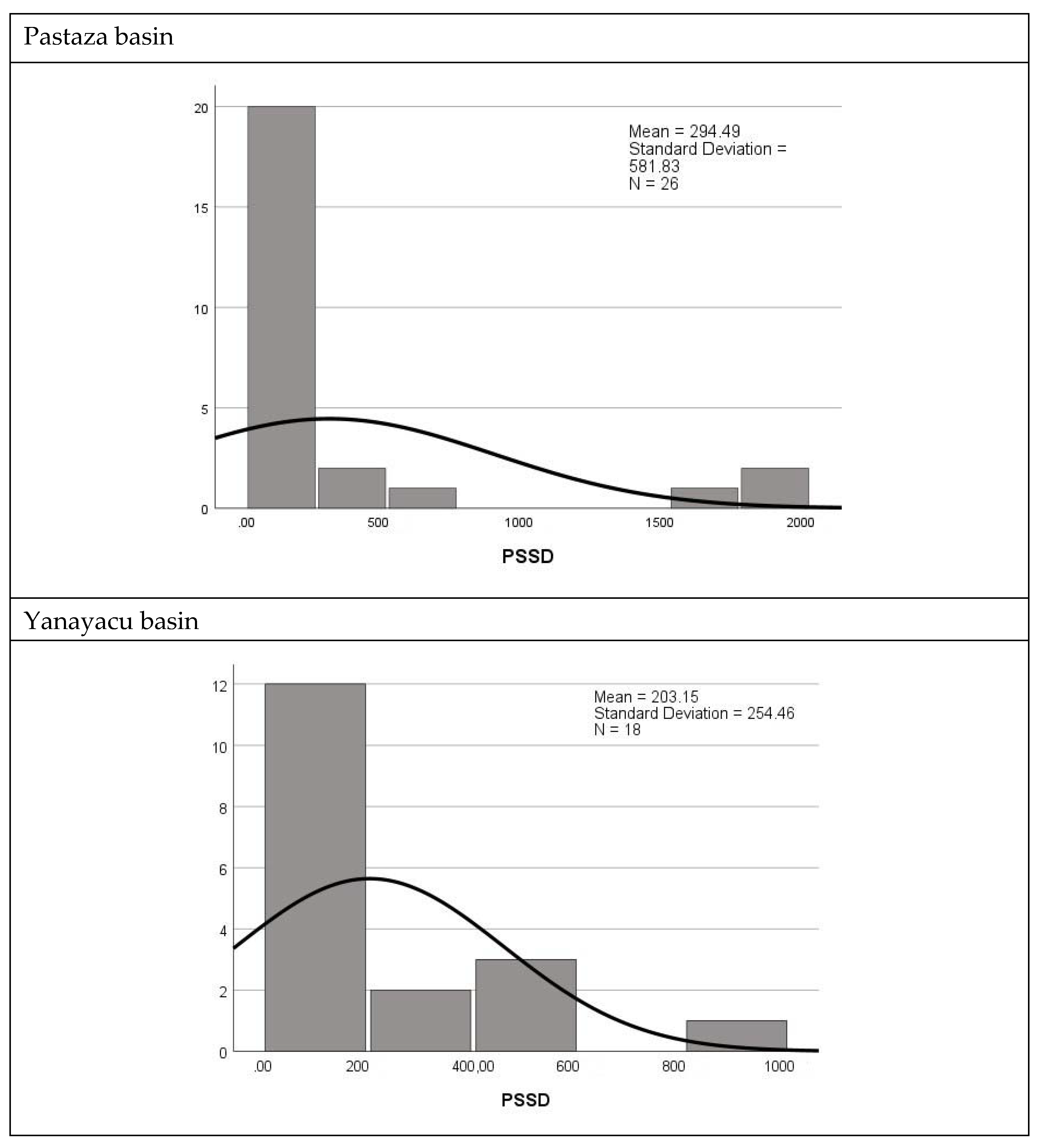
| Landscape Metric | Description | Value Range | Reference |
|---|---|---|---|
| Mean Patch Size (MPS) | Average patch size. | MPS ≥ 0 | [54] |
| Shannon’s Evenness Index (SEI) | The measure of patch distribution and abundance is based on several classes. m: number of classes. p: relation between class area and landscape area. | From zero (0) to one (1). 0: distribution of patches is low. One or near: distribution of classes is more even. | [54,55] |
| Rate of change (RC) | Measure an overall area change in classes through time. It is expressed in percentage. | From (0) to 100%. | [55] |
| Expansion Index (LEI) | Measure of growing type: infilling, edge-expansive and outlying. : shared perimeter length between new and former patch : perimeter of new patch | From zero (0) to 100%. | [55] |
| 1991 | 2001 | 2016 | ||||
|---|---|---|---|---|---|---|
| Kappa Coefficient | Overall Accuracy (%) | Kappa Coefficient | Overall Accuracy (%) | Kappa Coefficient | Overall Accuracy (%) | |
| Jatunyacu River Basin | 0.95 | 96.00 | 0.91 | 92.69 | 0.92 | 95.23 |
| Yanayacu River Basin | 0.94 | 95.27 | 0.92 | 93.44 | 0.96 | 96.91 |
| Pastaza River Basin | 0.94 | 95.97 | 0.95 | 96.95 | 0.95 | 96.24 |
| Period: 1991 to 2001 | ||||
|---|---|---|---|---|
| Classes | RC (%) | Expansion Index (LEI) km2/Year and Percentage | ||
| Infilling | Edge-Expansive | Outlying | ||
| Area without land cover | 4.28 | 0.30 (10.28%) | 1.11 (37.50%) | 1.54 (52.22%) |
| Agricultural Use | −6.51 | 0.32 (6.88%) | 2.81 (59.74%) | 1.57 (33.38%) |
| Water | −2.85 | 0.00 (0.39%) | 0.24 (64.72%) | 0.13 (34.89%) |
| Wood | 0.84 | 13.81 (72.93%) | 4.92 (25.96%) | 0.21 (1.11%) |
| Floodable grassland Paramo | −3.33 | 1.29 (45.84%) | 1.32 (46.95%) | 0.20 (7.21%) |
| Grassland Paramo | 1.29 | 10.57 (58.49%) | 6.92 (38.32%) | 0.58 (3.19%) |
| Snow | 6.39 | 0.00 (0.24%) | 0.55 (80.46%) | 0.13 (19.29%) |
| Period: 2001 to 2016 | ||||
| Area without land cover | −7.99 | 0.06 (14.94%) | 0.26 (61.53%) | 0.10 (23.54%) |
| Agricultural Use | 8.26 | 0.55 (3.04%) | 11.41 (63.22%) | 6.09 (33.73%) |
| Water | −4.59 | 0 (0%) | 0 (100%) | 0 (0%) |
| Wood | −0.28 | 2.66 (35.93%) | 3.59 (48.47%) | 1.16 (15.59%) |
| Floodable grassland Paramo | −7.44 | 0.15 (24.90%) | 0.32 (52.52%) | 0.14 (22.58%) |
| Grassland Paramo | −2.48 | 2.86 (66.75%) | 1.30 (30.34%) | 0.12 (2.91%) |
| Snow | −11.79 | 0.01 (1.24%) | 0.64 (79.51%) | 0.15 (19.25%) |
| Period: 1991 to 2001 | ||||
|---|---|---|---|---|
| Classes | RC (%) | Expansion Index (LEI) km2/Year and Percentage | ||
| Infilling | Edge-Expansive | Outlying | ||
| Agricultural Use | 1.48 | 0.87 (31.43%) | 1.41 (50.82%) | 0.49 (17.75%) |
| Water | −1.51 | 0.0002 (7.96%) | 0.0016 (75.30%) | 0.0004 (16.73%) |
| Wood | 10.55 | 0.04 (7.13%) | 0.20 (39.45%) | 0.27 (53.42%) |
| Floodable grassland Paramo | 9.53 | 0.35 (8.13%) | 2.88 (66.40%) | 1.10 (25.46%) |
| Grassland Paramo | −3.72 | 0.17 (45.88%) | 0.15 (40.13%) | 0.05 (14.00%) |
| Antropic Zones | 1.43 | 0 (0%) | 0 (0%) | 1.63 (100%) |
| Period: 2001 to 2016 | ||||
| Agricultural Use | 1.10 | 0.42 (14.05%) | 2.23 (74.36%) | 0.35 (11.59%) |
| Water | 0.53 | 0.0015 (5.67%) | 0.02 (92.74%) | 0.0004 (1.59%) |
| Wood | −10.79 | 0.0001 (1.67%) | 0.0040 (55.72%) | 0.0031 (42.61%) |
| Floodable grassland Paramo | −2.65 | 0.13 (25.85%) | 0.29 (59.08%) | 0.07 (15.06%) |
| Grassland Paramo | −0.60 | 0.82 (51.73%) | 0.73 (45.61%) | 0.04 (2.66%) |
| Antropic Zones | 4.78 | 0.33 (25.32%) | 0.61 (46.76%) | 0.36 (27.93%) |
| Period: 1991 to 2001 | ||||
|---|---|---|---|---|
| Classes | RC (%) | Expansion Index (LEI) km2/Year and Percentage | ||
| Infilling | Edge-Expansive | Outlying | ||
| Area without land cover | −12.91 | 0.02 (21.02%) | 0.08 (75.00%) | 0.0042 (3.97%) |
| Agricultural Use | −2.46 | 0.67 (20.30%) | 1.70 (51.67%) | 0.92 (28.03%) |
| Water | −7.31 | 0.03 (2.60%) | 0.64 (58.72%) | 0.42 (38.68%) |
| Wood | 1.47 | 10.08 (70.76%) | 3.69 (25.92%) | 0.47 (3.32%) |
| Floodable grassland Paramo | −22.34 | 0.0001 (1.05%) | 0.0008 (9.43%) | 0.0076 (89.52%) |
| Grassland Paramo | 0.70 | 1.35 (42.58%) | 1.62 (51.05%) | 0.20 (6.38%) |
| Snow | 13.71 | 0 (0%) | 0.21 (85.00%) | 0.04 (15.00%) |
| Antropic Zones | 1.51 | 0.03 (6.09%) | 0.14 (33.09%) | 0.27 (60.83%) |
| Period: 2001 to 2016 | ||||
| Area without land cover | −0.66 | 0.0001 (0.04%) | 0.03 (10.79%) | 0.28 (89.17%) |
| Agricultural Use | 1.81 | 0.87 (18.40%) | 2.55 (53.96%) | 1.31 (27.65%) |
| Water | −5.08 | 0.01 (5.07%) | 0.09 (33.96%) | 0.17 (60.96%) |
| Wood | −0.54 | 1.19 (56.11%) | 0.84 (39.41%) | 0.096 (4.48%) |
| Floodable grassland Paramo | 2.18 | 0 (0.00%) | 0 (0%) | 0.0088 (100.00%) |
| Grassland Paramo | 0.37 | 0.83 (45.14%) | 0.69 (37.17%) | 0.33 (17.69%) |
| Snow | No Data | No Data | No Data | No Data |
| Antropic Zones | 3.76 | 0 (0%) | 0 (0%) | 0.75 (100.00%) |
Disclaimer/Publisher’s Note: The statements, opinions and data contained in all publications are solely those of the individual author(s) and contributor(s) and not of MDPI and/or the editor(s). MDPI and/or the editor(s) disclaim responsibility for any injury to people or property resulting from any ideas, methods, instructions or products referred to in the content. |
© 2023 by the authors. Licensee MDPI, Basel, Switzerland. This article is an open access article distributed under the terms and conditions of the Creative Commons Attribution (CC BY) license (https://creativecommons.org/licenses/by/4.0/).
Share and Cite
Rosero, C.; Otero, X.; Bravo, C.; Frey, C. Multitemporal Incidence of Landscape Fragmentation in a Protected Area of Central Andean Ecuador. Land 2023, 12, 500. https://doi.org/10.3390/land12020500
Rosero C, Otero X, Bravo C, Frey C. Multitemporal Incidence of Landscape Fragmentation in a Protected Area of Central Andean Ecuador. Land. 2023; 12(2):500. https://doi.org/10.3390/land12020500
Chicago/Turabian StyleRosero, Carlos, Xosé Otero, Cinthya Bravo, and Catherine Frey. 2023. "Multitemporal Incidence of Landscape Fragmentation in a Protected Area of Central Andean Ecuador" Land 12, no. 2: 500. https://doi.org/10.3390/land12020500
APA StyleRosero, C., Otero, X., Bravo, C., & Frey, C. (2023). Multitemporal Incidence of Landscape Fragmentation in a Protected Area of Central Andean Ecuador. Land, 12(2), 500. https://doi.org/10.3390/land12020500










